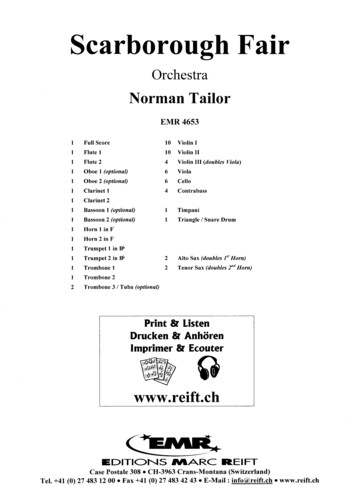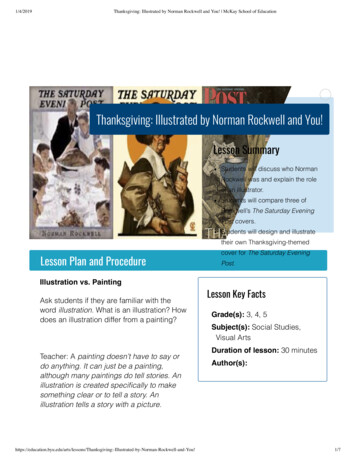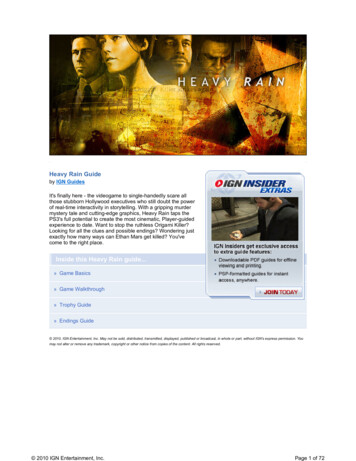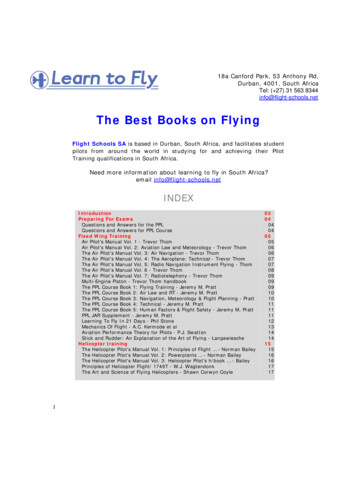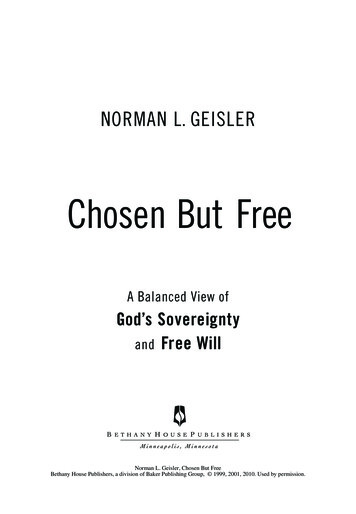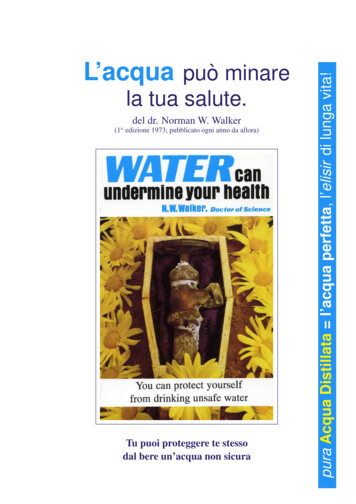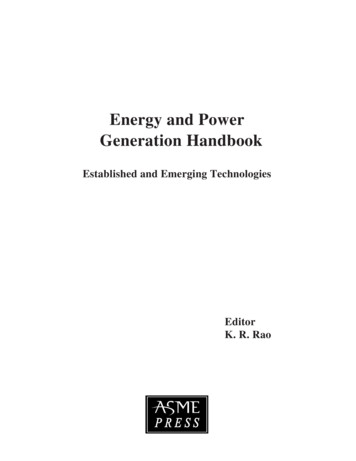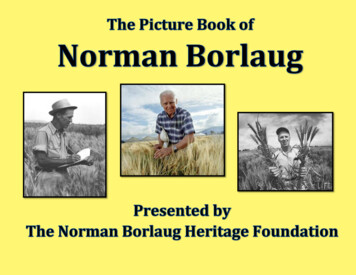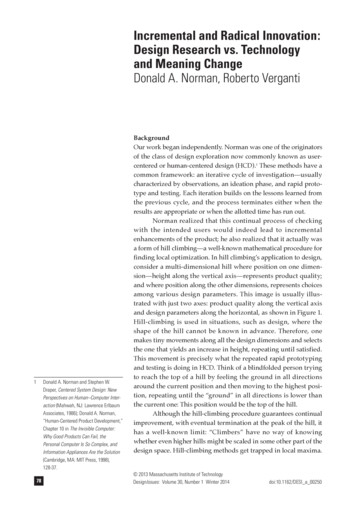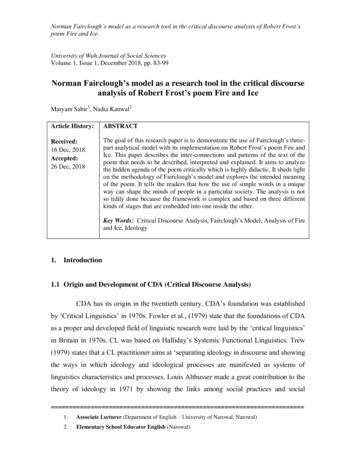
Transcription
Norman Fairclough’s model as a research tool in the critical discourse analysis of Robert Frost’spoem Fire and Ice.University of Wah Journal of Social SciencesVolume 1, Issue 1, December 2018, pp. 83-99Norman Fairclough’s model as a research tool in the critical discourseanalysis of Robert Frost’s poem Fire and IceMaryam Sabir1, Nadia Kanwal2Article History:ABSTRACTReceived:16 Dec, 2018Accepted:26 Dec, 2018The goal of this research paper is to demonstrate the use of Fairclough‟s threepart analytical model with its implementation on Robert Frost‟s poem Fire andIce. This paper describes the inter-connections and patterns of the text of thepoem that needs to be described, interpreted and explained. It aims to analyzethe hidden agenda of the poem critically which is highly didactic. It sheds lighton the methodology of Fairclough‟s model and explores the intended meaningof the poem. It tells the readers that how the use of simple words in a uniqueway can shape the minds of people in a particular society. The analysis is notso tidily done because the framework is complex and based on three differentkinds of stages that are embedded into one inside the other.Key Words: Critical Discourse Analysis, Fairclough‟s Model, Analysis of Fireand Ice, Ideology1.Introduction1.1 Origin and Development of CDA (Critical Discourse Analysis)CDA has its origin in the twentieth century. CDA‟s foundation was establishedby „Critical Linguistics‟ in 1970s. Fowler et al., (1979) state that the foundations of CDAas a proper and developed field of linguistic research were laid by the „critical linguistics‟in Britain in 1970s. CL was based on Halliday‟s Systemic Functional Linguistics. Trew(1979) states that a CL practitioner aims at „separating ideology in discourse and showingthe ways in which ideology and ideological processes are manifested as systems oflinguistics characteristics and processes. Louis Althusser made a great contribution to thetheory of ideology in 1971 by showing the links among social practices and social 1.Associate Lecturer (Department of English – University of Narowal, Narowal)2.Elementary School Educator English (Narowal)
Maryam Sabir, Nadia Kanwalinstitutions as well. Volosinov‟s work in 1973 can be called the first linguistic theory ofideology. According to Fowler et al., (1979) CL points out that, “There are strongconnections between linguistic structures and social structures” (p.185). Fowler et al(1979) state that “Language is an integral part of social process” (p.189). It is with therise of Systemic Functional Linguistics that DA had started to focus on the ways bywhich social and personal processes are encoded in the various texts. Fitch (2005)describes that the previous Discourse Analysis mostly focuses on the internal structure oftexts. Halliday has a wonderful influence on DA as he gave field, tenor and mode as Metafunctions of language which consists of phonology, lexicon-grammar and semantics.Halliday (1979) states that a particular text is a process as well as a product which iscreated, embedded and interpreted in a social context.The word „critical‟ is also associated with Discourse Analysis. By the end oftwentieth century, Chouliaraki, Fairclough and Van. Dijk used the word „CriticalDiscourse Analysis‟ frequently because the CL had been further enhanced, broadenedand developed. Fairclough (1995) has raised two issues and complained that the previousand the earliest work in Critical Linguistics had ignored the „interpretive practices ofaudiences‟. The earliest CL believed that the audience and the readers interpret the text inthe same way in which the analyst interpret. The second issue that was nominated byFairclough in 1995 is; the earliest CL did not focus on the „intertextual analysis of text‟.He further claimed that: “the linguistic analysis of early CL is very much attached toclauses with little attention with little attention to higher-level properties of whole texts”(p.28). Despite of the reality that Fairclough had pointed out the limitations of early CL,he also praised the achievements of CL in 1995.1.2 Van. Dijk’s Contribution to CDAVan. Dijk (1988) claims that, “Discourse is not simply an isolated textual ordialogic structure. Rather it is a complex communicative event that also embodies asocial context, featuring participants as well as production and reception processes (p.2).84
Norman Fairclough’s model as a research tool in the critical discourse analysis of Robert Frost’spoem Fire and Ice.So Van.Dijk‟s analysis of media discourse focuses not only on the structural andsemantic analysis but also on the higher level properties such as coherence, themes,headlines of news and the whole schematic and rhetorical dimensions of texts.1.3 Ruth Wodak’s Contribution to CDARuth Wodak constructs her model on „Sociolinguistics‟ and on the notions ofFrankfurt school, particularly of Jurgen Habermas. According to Wodak (1996)“Discourse Sociolinguistics is a sociolinguistics which not only is definitely dedicated tothe study of text in context but also gives equal weight age to both factors” (p.209). It is akind of approach that can identify and describe the underlying mechanisms that are thepart of those disorders in a discourse which are embedded in a particular context. Wodakhas carried out most of his research on the vital social issues like sexism, anti-Semitism,and racism. Her research work on anti-Semitism discourse in 1990 led to the constructionof an approach that is named as “Discourse Historical Method”. The term „Historicalattempts “to integrate all available background information in the interpretation andanalysis of a text” (1995, p.209). The research shows that the context of a discourse playsa vital role in the function and structure of an utterance. So the historical context ofdiscourse, in the analysis of a text, is a feature that makes it better than the earlierapproaches and theories in Critical Discourse Analysis. The „Discourse HistoricalMethod Approach‟ is similar to Norman Fairclough‟s idea of inter textuality as thisapproach believes that language “shows social processes and interactions and buildsthose processes as well” (Wodak and Ludwig, 1999, p.12). According to Wodak andLudwig (1999), “Discourse Historical Method Approach entails three main things;Firstly, Discourse always involves power relations and relevant ideologies. Secondly,discourse is always highly historical as it is connected with the events that had happenedbefore or happening at the production of a text. Thirdly, the readers and listeners mayhave different interpretations of the same text just because of their different backgroundknowledge, information and position (p.12, 13). Wodak and Ludwig (1999) also maintainthe notion that “the right interpretation does not exist. Interpretations can be plausible but85
Maryam Sabir, Nadia Kanwalthey can be false” (p.13). The same sort of question also raised by Fairclough earlier in1995.1.4 Relation of Discourse with IdeologyAccording to Widdowson (2000), Critical Discourse Analysis is an attempt tounveil the hidden ideologies in the texts. The notion of „Ideology‟ seems very importantin Critical Discourse Analysis as many linguists talk about it in their frameworks ofCDA. According to Hodge and Kress (1993), “Ideology contains an organizedrepresentation of reality”. Van.Dijk (1997) illustrates the same fact as the central point inthe analysis of a text is to show that „how various ideologies are manifested in differentkinds of text structures‟. There are three dimensions of Van. Dijk‟s ideology analysis;discourse, socio-cognition and social analysis. Some other linguistic theorists also presentdifferent dimensions of Critical Discourse Analysis in relation with ideology. Cameron(1992) describes some „stereotypes‟ which lead to social hegemonies. Reichenbach(2001) states that texts are replete with ideologically driven contents. Texts cannot be freeof contexts and the contexts are connected with the ideology of social systems. As thetexts are not neutral ideologically therefore language and text play a crucial role inmanifesting, distinguishing, changing and even reproducing ideologies. Fairclough(1989) is of the view that the word Critical is added in Discourse Analysis in order to befocused on the main issue, ideology or the “basic hidden agenda” in the text and talkthat has an original context. People have different ideologies regarding various things thatexist in the community and society in which they live. They talk about different things inan opaque and invisible way that is why it is called “Hidden Agenda” by Fairclough.In a nutshell, it can be said that a text reflects and constructs ideology that canonly be explored with the help of CDA frameworks. Ideology is the strongest when itbecomes invisible. When ideology becomes a part of everyday common sense then thediscourse becomes natural. Words are available for the speakers and writers to expressthemselves unconsciously and naturally. It is the ideology that constitutes the identities86
Norman Fairclough’s model as a research tool in the critical discourse analysis of Robert Frost’spoem Fire and Ice.and constructions of the world. With the change of ideology, new discourses arise for thepeople to produce and speak in the world. For the time being the production andreception of discourse transforms. For example, the formation of new discursivehegemony is also possible that can replace the old one. That is why the importance ofCDA studies is more than DA studies because it starts with a fixed research topic or issueand explores the cave of a speaker‟s or writer‟s mind and tries to steal the hidden agendaor invisible ideology like an explorer. CDA jumps into the cave of mind by describing amap which is based on the words of a speaker or writer as rigorously as possible andexplores the precious treasure of intention. As soon as the intention is interpreted, theinvisible agenda becomes vivid. CDA snatches the mask and tells that how words are atool to become a racist, moralist, conservative, liberal, terrorist and anti-terrorist etc.1.5 Objective of the ResearchThe objective of the research is to sort out the hidden ideology of Robert Frostin producing the text of the poem „Fire and Ice‟ by using Fairclough‟s Model as aframework of research.1.6 Research QuestionWhat kind of ideology is presented by Robert Frost in his poem Fire and Ice?2.Literature ReviewCary and Mutua (2010) to study the social structures and discursive relationspresent in them by using Norman Fairclough‟s Model as a tool of research. They visitdifferent places such as Australia, US and Kenya in order to observe and do CriticalDiscourse Analysis.Ye (2011) studies Barak Obama‟s speech that he has delivered at the time ofvictory, in the light of SFL that is a basic criterion in Fairclough‟s Model at first stage ofanalysis. He analyzes a speech like most of the researchers. But this research paper is87
Maryam Sabir, Nadia Kanwalbased on the analysis of a poem according to the whole framework of Fairclough in orderto change the trend.Uggla (2011) tries to highlights the stereotypical images and colonial discoursesin Tourism Discourse by using Fairclough‟s three stage Model of Critical DiscourseAnalysis. She completes her study at the Gambian Beech.Kamalu and Tamunobelema (2013) explore the ideologies and identitiesconstructed in genres of literary texts. They used the mood analysis technique of SFLwhile this paper focuses on the dimensions of SFL with respect to Fairclough‟s Model inCritical Discourse AnalysisZahoor (2015) studies the emotional, psychological, political and social changesin various situations from the dropping of atomic bomb on Nagasaki to the incident of9/11 (World Trade Center).Noor et al. (2015) study the Interpersonal Metafunctions of The Last Address ofHoly Prophet (PBUH). They analyze the clauses of Holy Prophet‟s Last Address andexplain their functions.Most of these research papers focus on the implementation of one aspect of SFLwhile the rest of the papers try to implement Fairclough‟s Model on other types ofdiscourses. This very research paper attempts to analyze the genre of poetry which is notgiven importance by most of the researchers.3.Materials and Methods3.1 Research MethodologyThe Qualitative Research method is used in the present research as there is noneed of Quantitative measurement of data. Lincoln (2000) is of the view that theQuantitative research is an effective way of getting information about culture, norms,88
Norman Fairclough’s model as a research tool in the critical discourse analysis of Robert Frost’spoem Fire and Ice.values, attitudes and opinions of a particular population group. Furthermore, Jennifer(2000) favours Quantitative research as it is based on methods of data generation that areflexible rather than rigid. It is also sensitive to social settings of text production. So theresearch is strictly descriptive in nature.3.2 Research Framework3.2.1 Norman Fairclough’s Model in CDANorman Fairclough is a CDA scholar. He is the only person who elaborates thelink between power, language and ideology in his research in 1989. Fairclough haspresented a model in 1989 and revised it in 1995. His model is considered a hub aroundwhich the wheel of critical discourse analysis revolves. He was the first to design atheoretical framework for CDA and gave guidelines for text interpretation. Fairclough‟smodel consists of three-step process of analysis which is tied to three inter-relateddimensions of discourse which are given below.Text ProductionTEXTText ConsumptionSOCIOCULTURAL PRACTICES89
Maryam Sabir, Nadia KanwalFigure1: Norman Fairclough (1989) The object of analysis. The process through which the object is produced and received. The socio-historical conditions which control these processes. All of these dimensions need a separate kind of analysis which is given below.In this step by step analysis and by studying the forms of language, one candiscover the social processes and the ideology that is embedded in the language.Then the power relations that exist in the society can be found.3.2.1 Text Analysis (Description)The very first analytical attention of Fairclough‟s Model is „Text‟. According toFairclough (1995), text analysis includes the linguistic analysis. Fairclough (1995) alsostate that, “Linguistic analysis includes the analysis of the grammar, vocabulary, soundsystem, semantics and cohesion organization above the sentence level” (p.57).It is based on the linguistic description of the formal properties of text. Text is aform of data which is used for linguistic analysis. All the description of grammar is basedon text. The term „text‟ refers to a specimen of language in any medium spoken orwritten that makes sense to someone who knows the language. When people speak orwrite they produce text with which readers and listeners engage end interpret. So text is aprocess of making meaning in context (Halliday and Hassan, 1976). It All the notablegrammarians think that a text is a complex, rich and many-faceted phenomenon thatmeans in many different ways. It can be interpreted from different perspectives. For thelinguistic analysis Halliday‟s Functional Linguistic Theory of Grammar explains themeaning making resource of modern English. The model of grammar should be as rich asthe grammar itself (Halliday, 1984). For the description of text, the most noticeabledimension of language is its compositional structure that is known as constituency.Constituency means the larger units of language consist of smaller ones.90
Norman Fairclough’s model as a research tool in the critical discourse analysis of Robert Frost’spoem Fire and Ice.Figure 23.2.2Processing Analysis (Interpretation)It shows the relationship between discourse processes and the text. Reading is aproduct of an interface between the properties of the text and the interpretative resourcesand practices which the interpreter brings to bear upon the text. The range of potentialinterpretations will be constrained and delimited according to the nature of the text(Fairclough).3.2.3Social Analysis (Explanation)This stage is a relationship between discourse and social and cultural reality.The immediate condition, from which a text is evolved, is important for the authenticinterpretation of the text. This analysis focuses on the language and individual words thatshape a text. This approach does not mind if the analyst begins the analysis by selectingthe step of his own choice. One can select any stage to start the analysis which ultimatelycollaborate all the three steps in the end of discussion. Discourse is a part of social life isthe main belief of this framework.91
Maryam Sabir, Nadia Kanwal4.Data Analysis4.1Introduction of the poet Robert Frost as a Symbolist (1874-1963)Robert frost holds a separate and unique place in literature. Leonard Unger andWilliam Van O‟ Corner points out in „Poems for Study‟ that “Frost‟s poetry depicts nomarked difference from the poetry of the nineteenth century”. His poetry is profound withmoral values and didactic style which is wrapped up in symbols. So Frost‟s poetry needsto be understood. Frost himself says the same thing in an interview: “One thing isimportant about which I care and also want that the new generation should care about is,taking poetry as the first form of understanding. If poetry is not understanding the wholeworld, it is not worth anything.4.1 Introduction of the selected text for analysisFire and Ice is one of the most prominent poems that holds so manycharacteristics and makes a body of work for Frost. It was published in 1923. It is onlynine lines long poem which is an excellent example of Robert Frost‟s literary work. Itslanguage is simple and vernacular that can be easily understood. Let the CDA exploreand highlight the underlying theme and ideology from this text of the poem that is givenbelow.4.2 Fire and IceSome say the world will end in fire;Some say in Ice.From what I‟ve tasted of desireI hold with those who favor fire.But if it had to perish twice,I think I know enough of hateTo say that for destruction iceIs also great and would suffice.92
Norman Fairclough’s model as a research tool in the critical discourse analysis of Robert Frost’spoem Fire and Ice.4.3 Poetry as a separate form of textSince past times, literature had been used as a tool in the catharsis of the worldwhich is a way of purification. In his essay „The Study of Poetry, Mathew Arnold (1880)states that, “Poetry is a criticism of life”. It means that poetry should be a true andsound manifestation of life. He also states in the same essay that “without poetry, ourscience is incomplete”. He considers „high truth‟ and „high seriousness‟ as a criterion forjudging the value of poetry. Poetry should also conform to the norms of „poetic truth‟ and„poetic beauty‟ by sticking to facts of life as a subject matter of it.All poetry evolves from a rich array of patterns of its own. Every language hasits own natural rhythm. When someone reads a poem spontaneously without payingattention to the process of speaking then the strong syllables tend to occur at properintervals that are called a rhythmic progression with which the listener keeps in phase. Arhythmic progression demonstrates a form of constituency. In poetry, the foot is aconstituent of second system of English. The foot in poetry also has its origin in the footof spoken language. The „metric foot‟ a foot with fixed number of syllables, had beenused in poetry since the time of Chaucer. It remained the norm of the mainstream ofEnglish verse in the past few centuries. The pentameter or five feet verse in the poetrywas the favorite of Chaucer, Milton, Shakespeare, Pope and Keats. A foot might havetwo, three or four syllables but it might also be ascending and descending. The twosyllabic foot might be trochaic (strong weak) and iambic (weak strong). Catford(1977) state that “A syllable is a fundamental unit of an articulatory gesture”. Like thefoot, a syllable is also a structured unit. It is composed of an Onset Rhyme. Onset is aconsonant phoneme while the Rhyme can be a vowel consonant or consonant phoneme.In the twentieth century, it stopped to dominate the new English verse and new forms ofrhythms have been Included in poetry.93
Maryam Sabir, Nadia Kanwal4.4 Text Analysis4.4.1 Transitivity and Functional GrammarThe line by line analysis of the selected text of the poem by following Halliday‟sSystemic Functional Linguistic is given below.The indefinite pronounVerbModalitySomeSaythe world will end in fire,SayerProcessVerbiageThis very first line of the text is a simple statement which is a kind ofproposition. Modality is also present in this verse. Subject is uncertain as it is comprisedof an indefinite pronoun “some”. According to Transitivity, the process is verbial.IdentityVerbFrom whathave tastedIdentityverbIholdof desire,With thoseIwho nomenonThe second line of the poem is also a statement in which he favors the destructivequality of fire as he himself experiences fire in the form of emotion. So the process ofTransitivity is Mental here.ConditionalVerbBut if ithad ctorProcessenough ofhate,SensorProcessSensorProcessPhenomenon94
Norman Fairclough’s model as a research tool in the critical discourse analysis of Robert Frost’spoem Fire and Ice.This line is a kind of conditional statements in which the condition is if the world willend two times then hate can also destroy it as a cold passion like ice. There is modality inthis line. The material and sensor processes are functioning here.VerbTo saythat foris also greatConjunctionModal VerbAndwouldSuffice.destruction iceSayerProcessVerbiageThe last line is also simple statement that is linked with the previous line andrepresents the idea that hatred and ice can also destroy the whole world. Grammar isperforming the function of verbial process.4.4.2 Meta Functions of Language Field (Ideational function)The poem is based on a propositional content about the end of world which canbe proved right or wrong in future. Tenor (Interpersonal Function)The social role of Robert Frost is that of a poet here while the people have therole of readers. Mode (Textual Function)The selected text is compiled by the poet in written form.95
Maryam Sabir, Nadia Kanwal4.5 InterpretationIn the first lines of Fire and Ice, Frost puts forward two options for the end ofworld. He says that the fire and ice both have destructive powers. The poet relates firewith human passion of desire. The use of „I‟ shows the personal connection with thesehuman emotions. The final lines of the poem show the ideology that Fire and Ice in theguise of love and hate can harm the world and easily lead to its final destruction. The useof literary devices is also appropriate in making the intention of the poet clear. There isno cognitive problem in this text as the diction of the poem is very simple andunderstandable. As for as the power relations are concerned, the poet is powerful becausehe has the power of pen. Pen is mightier even than the sword so poet has utilized thispower to express his didactic ideas.4.6 ExplanationInterestingly in this poem, the poet talks about the two possible ways of thedestruction of world. These possibilities are directly related to a common scientificdebate that was running at the same time when Frost was compiling the poem Fire andIce. Some scientists thought that the world will be reduced to ashes from the fire of its hotcore. Some of them believed that an ice age would come and destroy all the livingcreatures on the surface of Earth. The immediate social context has always an influenceon the literary writers so Frost recommended more emotional side of the social situationby linking passionate love and desire with Fire and Ice with hatred. So Earth, Fire and Iceare taken by the debate of scientists and used as metaphors for relationship, love and hate.5.ResultsAfter analyzing the poem Fire and Ice through the lens of Norman Fairclough‟sModel of Critical Discourse Analysis, it is evident that the poet has a profound ideologyin this poem. He has a hidden intention that people should be moderate in their actionsand do not touch the extreme ends as they are devastating for the soul of mankind. As96
Norman Fairclough’s model as a research tool in the critical discourse analysis of Robert Frost’spoem Fire and Ice.poetry is a separate form of text so the poet also used „Symbolism‟ as a literary device toshow the real face of extremism. Fire and ice words are used as concrete symbols tohighlight the abstract ideas behind them. As a result, Frost successfully put forward hisideology that people should be moderate in all domains of life in order to create an idealsociety and healthy mindset. To conclude, it is sure to state that the above analyzed text ishighly didactic in nature. The readers can be impressed its thought provoking tone andideology which is really a food for thought. So CDA has explored the underlyingmeaning of the poem. It is enhanced by the virtue of Fairclough‟s Model as a researchtool in this research. It uncovers the moral lesson in the poem and teaches the readers tothe maximum extent. The only way to escape destruction of mankind is to avoid theextreme passions of love and hate. Too much passions can instantly consume arelationship in the same way in which the Fire and Ice can destroy the Earth.6. Limitations of the studyAlthough Norman Fairclough‟s Model in CDA can be applied to various genresof literature and on speeches as well but the present research is limited only to theanalysis of Robert Frost‟s poem Fire and Ice.7. ContributionThis paper will prove a great contribution to CDA in a sense that it is based onthe analysis of a poem and finds out its hidden ideology with the help of Fairclough‟sModel as a reliable research method.8. SuggestionsIt is suggested that Critical Discourse Analysis of poetry should be done more,in order to dig out hidden major themes and ideologies in the poems.97
Maryam Sabir, Nadia KanwalReferencesBanks, D. (2002). Systemic functional linguistics as a model for text analysis. Asp Varia,35-36.\Retrieved from asp.revues.org › Numéros › 35-36 › Articles on 2/3/14.Robert Frost: Fire and Ice, retrieved from www.poetryfoundation.comKamalu, I. &Tamunobelema, I. (2013). Linguistic Expression of Religious Identity andIdeology\in Selected Postcolonial Nigerian Literature. Canadian Social Science9(4). 78-84Kazemian, B., Behnam, B. &Ghafoori, N., (2013). Ideational grammatical metaphor inscientifictexts: A Hallidayan perspective. International journal of Linguistics,5(4), nam, B. &Kazemian, B. (2013). A comparative study of ideational grammaticalmetaphor in scientific and political texts. The Journal of Applied Linguistics andDiscourse Analysis, 1(1), 40-70.Kazemian, B., Behram, B. &Ghafoori, N., (2013). Ideational grammatical metaphor inscientific texts: A Hallidayan perspective. International journal of Linguistics,5(4), 146-168. http://dx.doi.org/10.5296/ijl.v5i4.4192Kazemian, B. &Hashemi, S., (2014b). Critical discourse analysis of Barack Obama's 2012speeches: Views from systemic functional linguistics and rhetoric. Theory andPractice in Language Studies, 4(6), 1178-1187. doi:10.4304/tpls.4.6.1178-1187Halliday, M.A.K. (1994). An Introduction to Functional Grammar (2nd Ed). London:EdwardArnold.Ye, R. (2010). The Interpersonal Metafunction Analysis of Barack Obama's. EnglishLanguage Teaching. 146. www.ccsenet.org/eltFairclough, &Wodak. (1997). Critical Discourse Analysis98
Norman Fairclough’s model as a research tool in the critical discourse analysis of Robert Frost’spoem Fire and Ice.Foucault, M. (2002). The Archaeology of Knowledge. London: Routledge.Wodak, & Meyer. (2009). Critical Discourse Studies: A Socio-cognitive ApproachAschroft, B. (1995). The Postcolonial Studies Reader. LondonFairclough, N. (1992). Discourse and Social Change. Cambridge PolityLoomba, (1998). Colonialism/Post colonialism. London: RoutledgeLouise, Marianne, & Jorgensen. (2002). Discourse Analysis as Theory and Method.LondonVan Dijk, (1990). Discourse and Society: A New Journal for a new Research FocusKazemian, B. &Hashemi, S., (2014b). Critical discourse analysis of Barack Obama's 2012speeches: Views from systemic functional linguistics and rhetoric. Theory andPractice in Language Studies, 4(6), 1178-1187. doi:10.4304/tpls.4.6.1178-1187Zahoor, A. (2015). Kamila Shamsie's Novel "Burnt Shadows": A Discourse of Traumaticdisplacement: Published by European Centre for Research Training andDevelopment UK (www.eajournals.org)Cary, L.J., & Mutua, K. (2010). Postcolonial Narratives: Discourse and EpistemologicalSpacesMoji, A. M. (2011). A systemic analysis of editorials in selected Nigerian n.edu.ng/studproj/arts/0715cd049.pdf on 26/2/14White, P. R. R. (2000). Functional Grammar. Birmingham: University of Birmingham.FredrikaUggla. (2011). It's Nice to be Nice: Tourism Discourse and Post-ColonialIdentities in The Gambia: Lund University,99
poem Fire and Ice. 87 and constructions of the world. With the change of ideology, new discourses arise for the people to produce and speak in the world. For the time being the production and reception of discourse transforms. For example, the formation of new discursive hegemony is also possible that can replace the old one.
